Best Home Security Cameras of 2024
When it comes to all-around ease of use, cost, and compatibility with smart home security, we found SimpliSafe to be the best security cameras for home use overall.
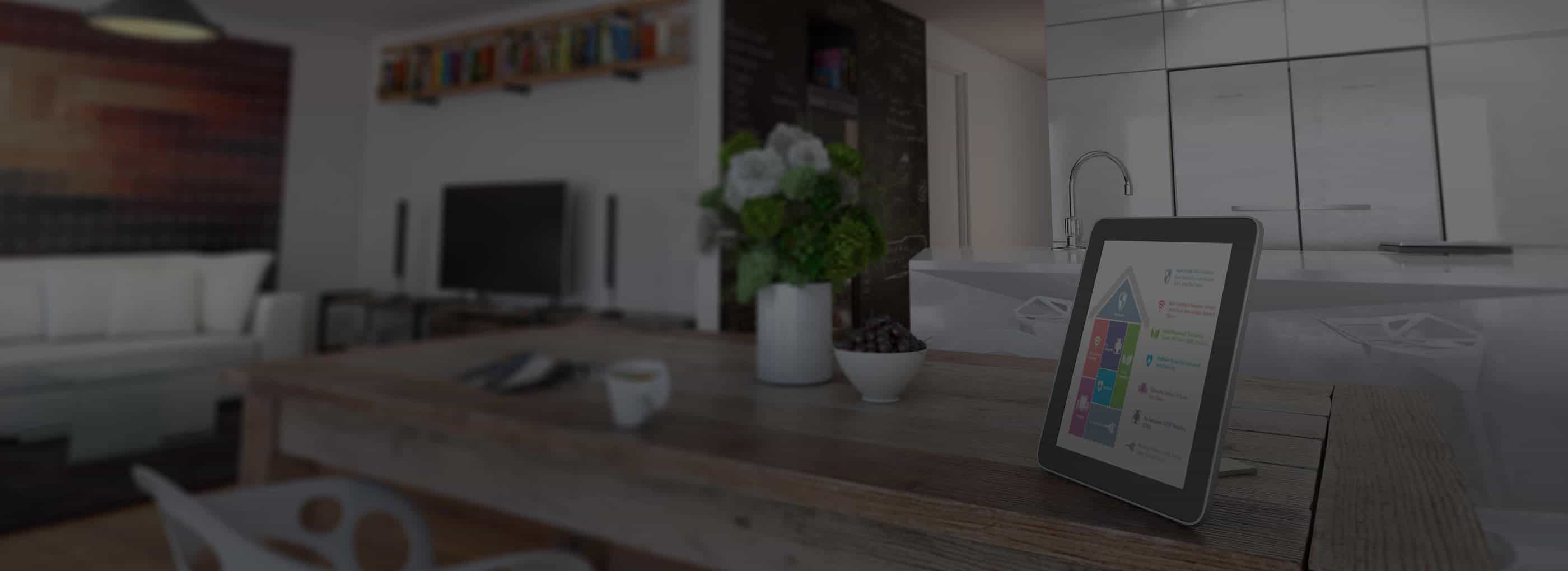
SafeHome.org may receive compensation from some providers listed on this page. Learn More
We may receive compensation from some providers listed on this page. Learn More
Best Security Camera Overall
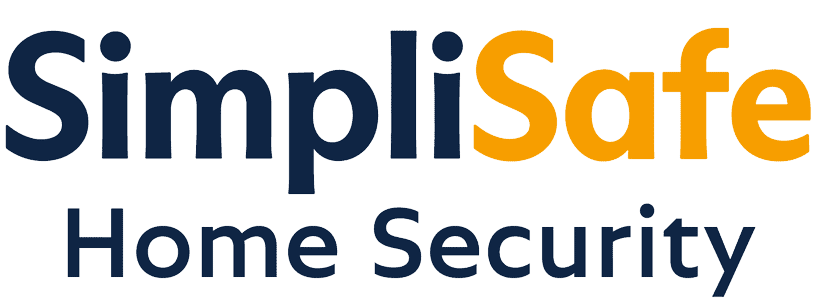
The SimpliCam now comes in indoor and outdoor models. These DIY products are a cinch to set up and come with HD video resolution, two-way talk, and other burglar-busting features. Just don’t expect a ton of bells and whistles.
Best Without a Subscription

Lorex offers plenty of powerful cameras with reliable technology and image resolution up to 4K in some models. And with lots of equipment and bundling options, Lorex cameras won’t break the bank.
Best Option for DIY Installation

The Amazon-owned Ring cameras are wireless, easy to install, high definition video cameras with inexpensive cloud storage. We love Ring’s app. You can share videos with family, neighbors and even local law enforcement.
Best Security Camera Overall
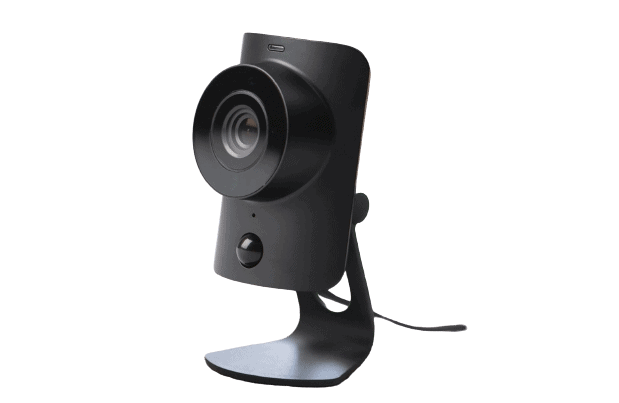
Best Without a Subscription
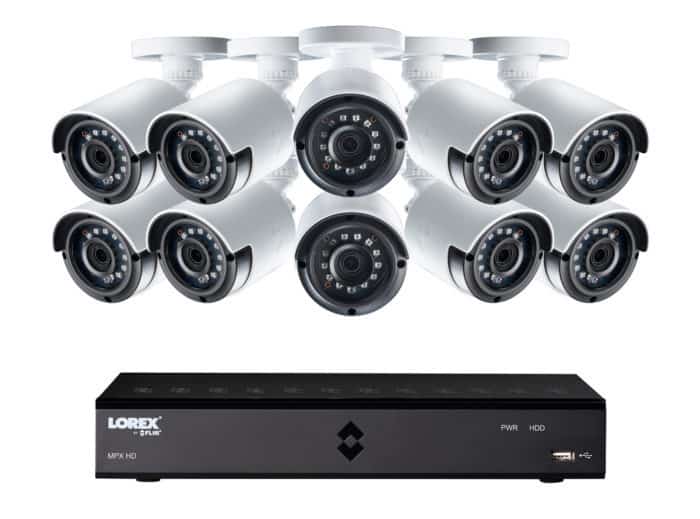
Bottom Line: The Lorex design and construction quality is second-to-none. And built-in DVR storage combined with impressive daytime video makes it a top choice for those willing to pay the price.
Best Option for DIY Installation
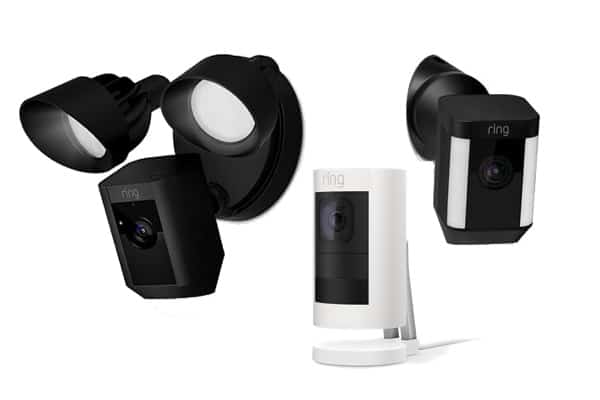
Bottom Line: Ring tops our list for being the best home security camera overall. They offer a lineup of versatile home security cameras that can be used indoor or outdoor.
Editor’s Note: It’s no shock that SimpliSafe cameras are the highest rated on our list. Especially when the SimpliSafe home security system is our favorite for home protection. Pairing SimpliSafe’s cameras with their security system works best to protect your home and family from burglars.
Our team of experts spent the first months of 2024 testing and ranking security cameras from the current top brands, and SimpliSafe secured the top spot. We found SimpliSafe’s indoor and outdoor cameras to be extremely well-rounded compared to options from other brands. It also offers affordable live camera monitoring – a feature unique only to SimpliSafe and one other brand we tested.
Of course, SimpliSafe might not fit your particular needs. So while you’ll find a complete rundown of SimpliSafe’s most important features below, you’ll also find information about some of the other home security cameras that made an impression on us. With that, let’s jump right in!

SimpliSafe currently offers three security cameras, the Wired Indoor Camera (previously known as the SimpliCam), the new Wireless Indoor camera, and the Wireless Outdoor Camera. All three impressed us. What we love most about SimpliSafe cameras, though, is that they are part of a complete DIY security system.
SimpliSafe doesn’t offer dozens of options like our 2nd (Lorex) and 3rd (Ring) picks do. But with a choice of both wired and wireless cameras indoor and outdoor cameras, we had enough choices to outfit our home. Inside, you can go with either a wired camera or the new wireless model. Out-of-doors, the SimpliSafe wireless outdoor camera runs on a rechargeable battery, so you never have to worry about tracking down an outside outlet or running an extension cord from inside. There’s no question though that what really sets SimpliSafe cameras apart is the fact that they’re connected to the complete SimpliSafe system. That includes SimpliSafe’s new Smart Alarm monitoring plan. Because no matter how good a camera might be, a camera that’s being monitored 24/7 by professionals is always going to be better.
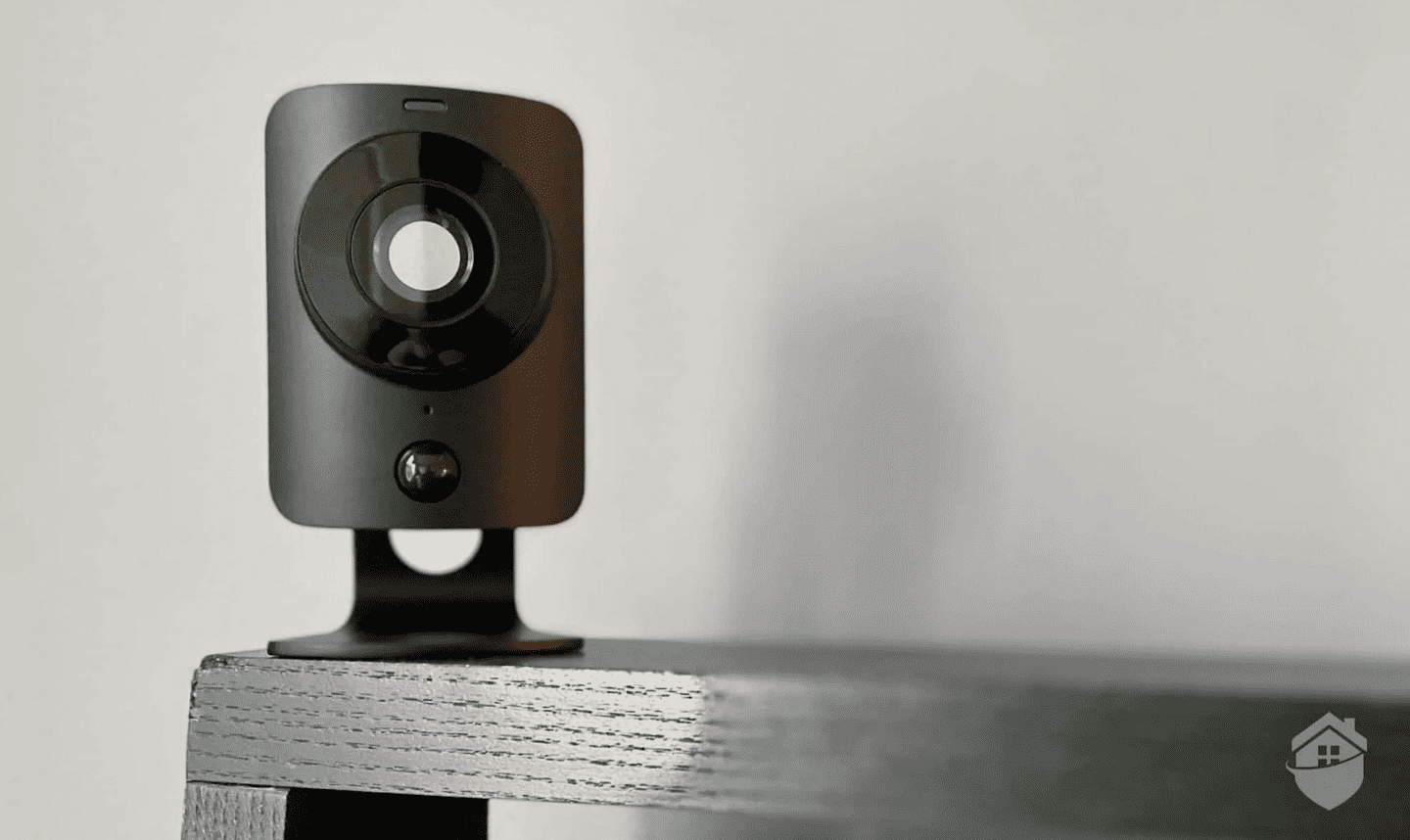
A SimpliSafe indoor SimpliCam
And don’t let the simplicity of SimpliSafe’s approach fool you. SimpliSafe cameras do an impressive job of protecting against burglars. The Smart Alarm and the outdoor camera work with the Live Guard Protection feature from SimpliSafe’s Fast Protect plan ($29.99 per month) to provide total security. Here’s how that feature worked in our testing:
The only other brand we tested that offered live monitoring was Ring. The SimpliSafe Fast Protect plan costs around $10 per month more than Ring’s monitoring plan, but SimpliSafe’s professional monitors can actually see what’s happening in your home and respond to it. We’d say that’s well worth $10 more each month. LiveGuard uses video verification to ensure emergency personnel are on site fast, and monitoring personnel are specially trained to try and drive burglars away themselves in the meantime.
You do need one of the new Wireless Indoor Cams to take advantage of all LiveGuard features. The SimpliCam allows for professional live video monitoring, including video verification, but it doesn’t include an audio link.
>> Read More: SimpliCam Hands-On Test and Review
SimpliSafe’s cameras strike a near perfect balance between functionality and affordability. They don’t offer a lot of bells and whistles, but they cost a lot less than the feature-rich but pricey Arlo cameras we tested.
Take a look at how each SimpliSafe camera measures up against each other.
| Features and Price | SimpliCam | Smart Alarm | Outdoor Camera Pro |
|---|---|---|---|
| Type | Indoor camera | Indoor camera | Indoor camera |
| Resolution | 1080p | 1536p | 1080p |
| Night vision | IR | IR | IR and spotlight |
| Field of view | 120-degrees | 125-degrees | 120-degrees |
| Two-way audio | Yes | Yes | Yes |
| Smart alerts | Yes | Yes | Yes |
| Power source | Plugged in | Battery or plugged in | Battery |
| Price | $99.99 | $139.99 | $189.99 |
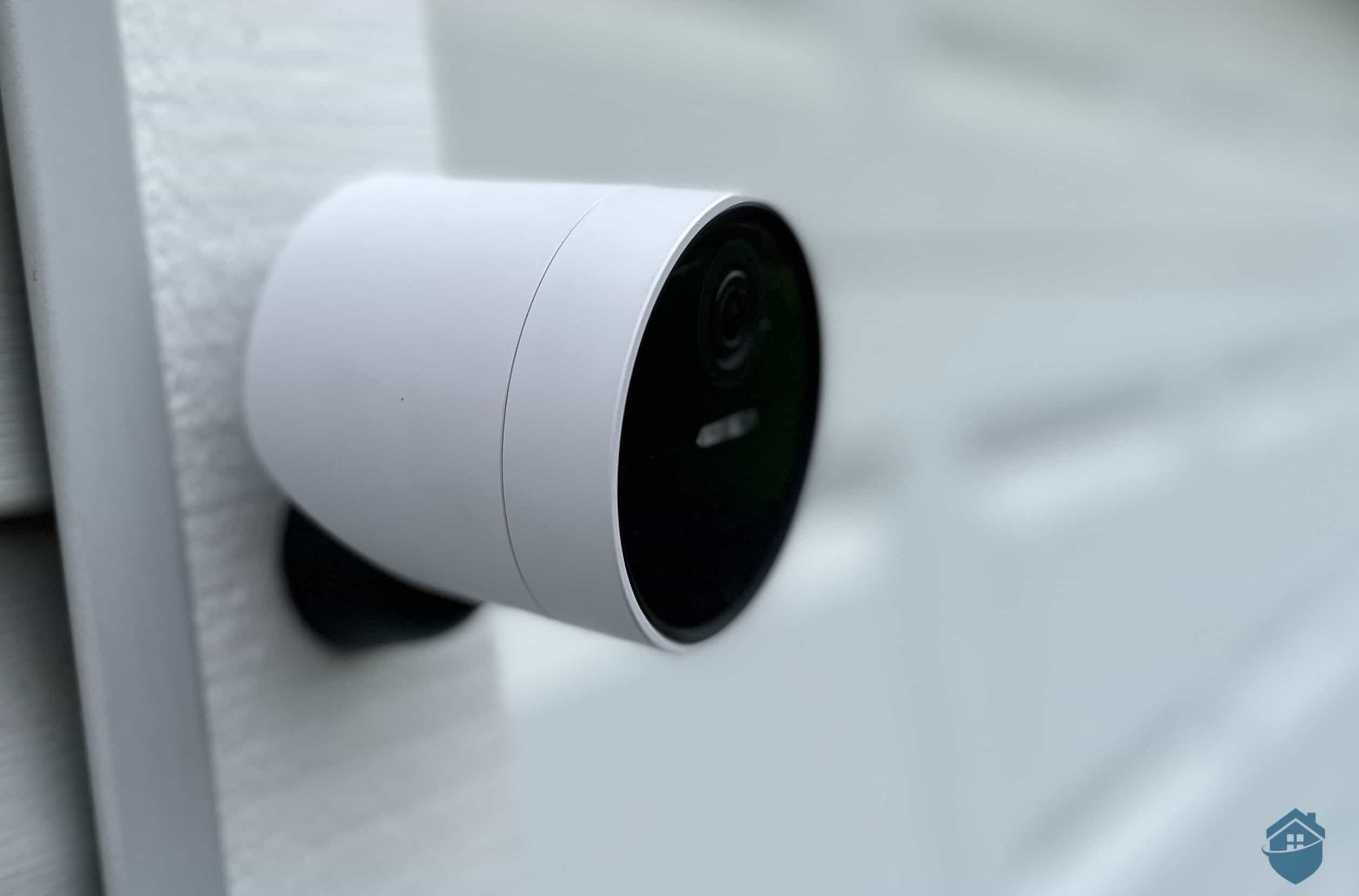
SimpliSafe Outdoor Camera on Garage
One of SimpliSafe’s downsides is that it doesn’t record without a cloud subscription. We had to sign up for a cloud plan for five cameras ($9.99 per month) but later realized we could do much better with the Fast Protect plan. Sure, it cost us three times as much, but it unlocked Live Guard Protection and video verification. Here’s a quick comparison of SimpliSafe’s security camera subscriptions:
| SimpliSafe Subscriptions | Cloud Recording Plan | Fast Protect Plan |
|---|---|---|
| Monthly cost | $4.99 (1 camera) to $9.99 (5 cameras) | $29.99 |
| Max no. of cameras | 1 to 5 | 10 |
| Cloud storage | 30 days | 30 days |
| Live Guard Protection | No | Yes |
| Video verification | No | Yes |
| Professional security system monitoring | No | Yes |
We were intrigued by the fact that SimpliSafe cameras come from a well-established security system brand, unlike options like Lorex and Swann that solely offer security cameras. But that aspect proved to be a double-edged sword.
There are serious advantages to using a camera as part of a home security system, and SimpliSafe isn’t just any system. It’s one of our top-rated security systems. That means we didn’t just have video feeds. We had a network of sensors and detectors that created a net of security around our home. Components worked in sync to keep us more protected than cameras alone.
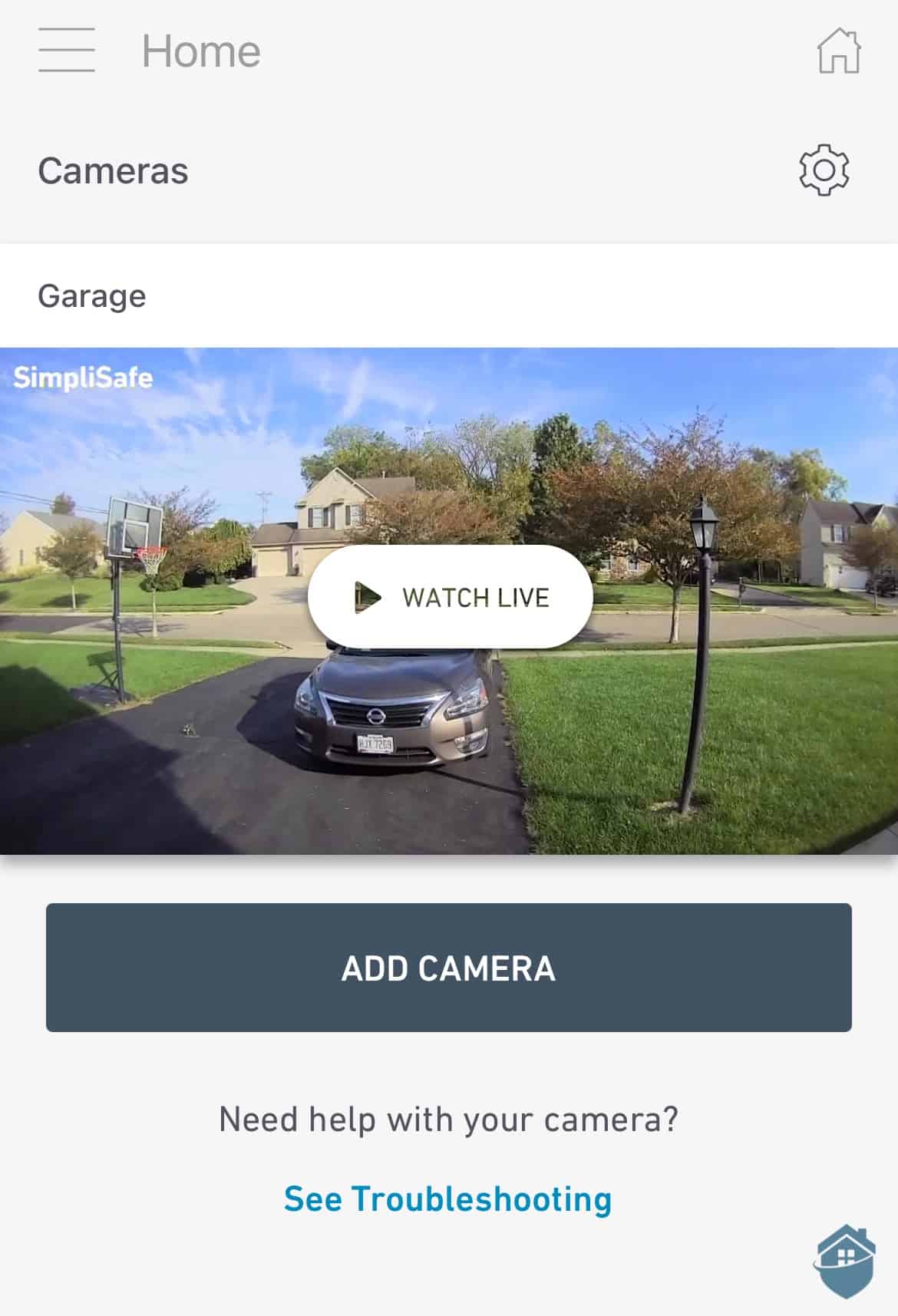
SimpliSafe’s Outdoor Camera video on the app
On the other hand, you can certainly save money with systems that let you buy cameras and don’t require you buy sensors and hubs. We should point out that you can use the SimpliCam as a standalone system with SimpliSafe’s Smart Alarm service. If you’re interested in an outdoor camera, though, you’re sort of locked into Live Guard Protection and that means you have to buy an entire system.
Still, it was well worth it. SimpliSafe’s security system is a great pick for home security. When you supplement it with SimpliSafe cameras – our top picks overall – you get a pretty impressive security outfit for your home.
FYI: The Fast Protect plan is a monitoring subscription for the SimpliSafe security system. As such, it requires a working SimpliSafe system.
| Connectivity | Wi-Fi |
|---|---|
| Power | Wired and Wireless |
| Field of View | Up to 125° |
| Resolution | Up to 1536p |
| Storage | Cloud |
| Smart Platform Compatibility | SimpliSafe security system, Alexa, Google Assistant |

Lorex got its start by providing security cameras for businesses, so its cameras are more sophisticated than SimpliSafe. We’re talking about cameras with up to 4K resolution and night vision that can reach hundreds of feet. Lorex’s other selling point is that the company charges no monthly fees. Once you’ve purchased equipment, you’re done. Of course, there’s a downside to that. You can’t get professional monitoring of any kind from Lorex. You do get a choice of local storage options, though, so you can record footage for free.
Picking your security cameras from Lorex isn’t going to be easy. This brand offers several dozen cameras and over two dozen more DVRs and NVRs. We loved the variety of options, but choosing just one camera can feel like drinking from a firehose.
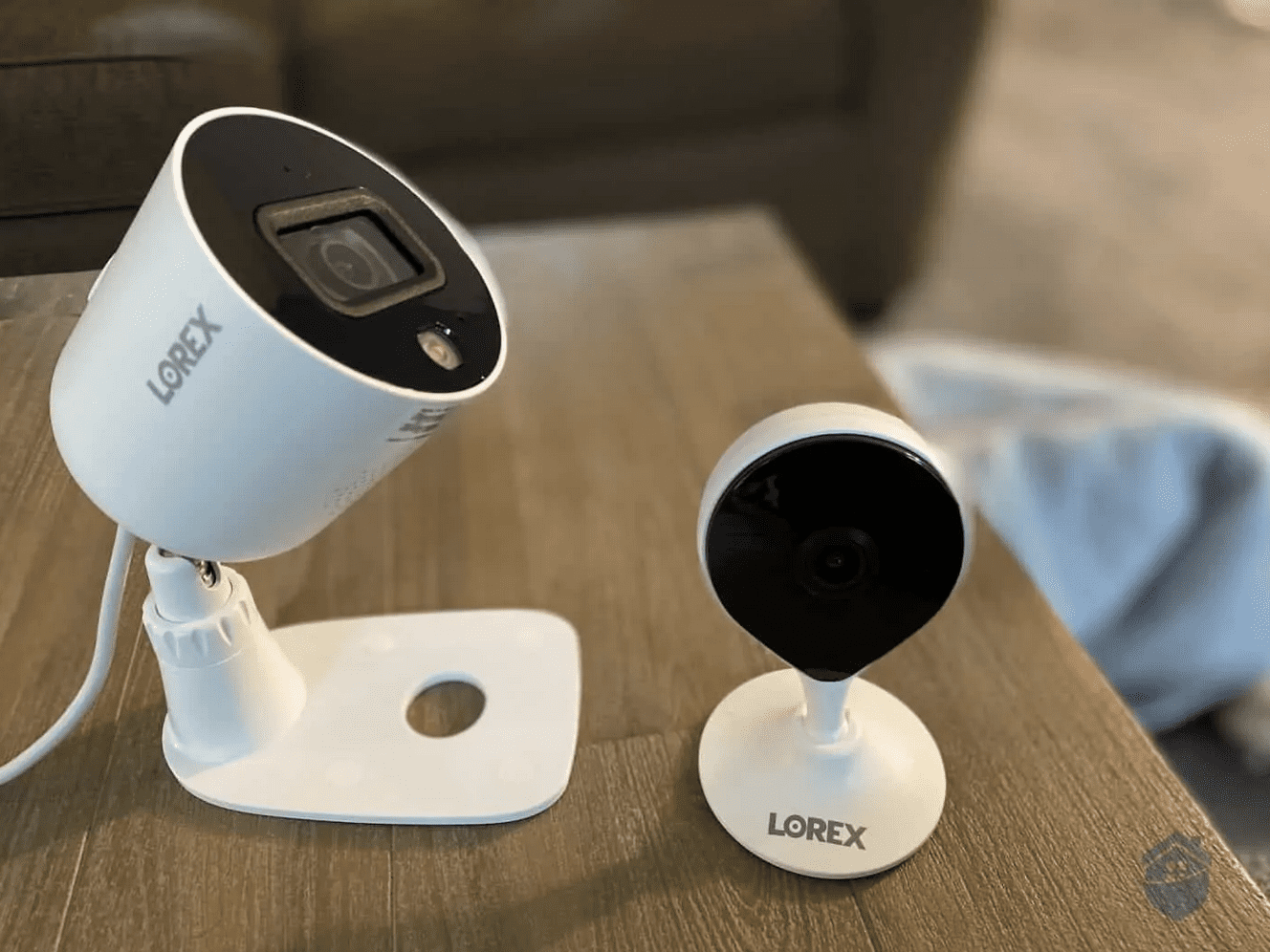
Lorex cameras
We chose from Lorex’s Fusion Collection, and we weren’t disappointed. The available NVR system from that line works with both wired and wireless cameras, which gave us more versatility in how we set up our system. We chose one wireless outdoor camera and one wireless indoor camera, but the Fusion line has lots of additional options. You can read more about our experience in our Lorex review, but here’s a quick specs highlight:
| Specs | Lorex Smart Wi-Fi Camera | Lorex Outdoor Wi-Fi Camera |
|---|---|---|
| Resolution | 1080p HD | 1080p HD |
| Field of view | 115-degrees | 129-degrees |
| Two-way audio | Yes | Yes |
| Connectivity | Wi-Fi | Wi-Fi |
| Power source | Outlet (10-foot cable included) | Outlet (20-foot cable included) |
| Recording options | Local and cloud | Local and cloud |
Later on, we also purchased two Lorex 4K outdoor cameras. Those made our list of the best 4K cameras because they came with a unique feature called Smart Deterrence, which highlights Lorex’s ability to deter burglars. Here’s how it worked:
You’ll still need to trigger the siren manually. That’s why we think Lorex’s Smart Deterrence isn’t as great as SimpliSafe’s Live Guard Protection. It’s just not as proactive at deterring crime as SimpliSafe. But if you’re looking for security cameras that can deter criminals, Lorex is definitely a better pick than most other camera options.
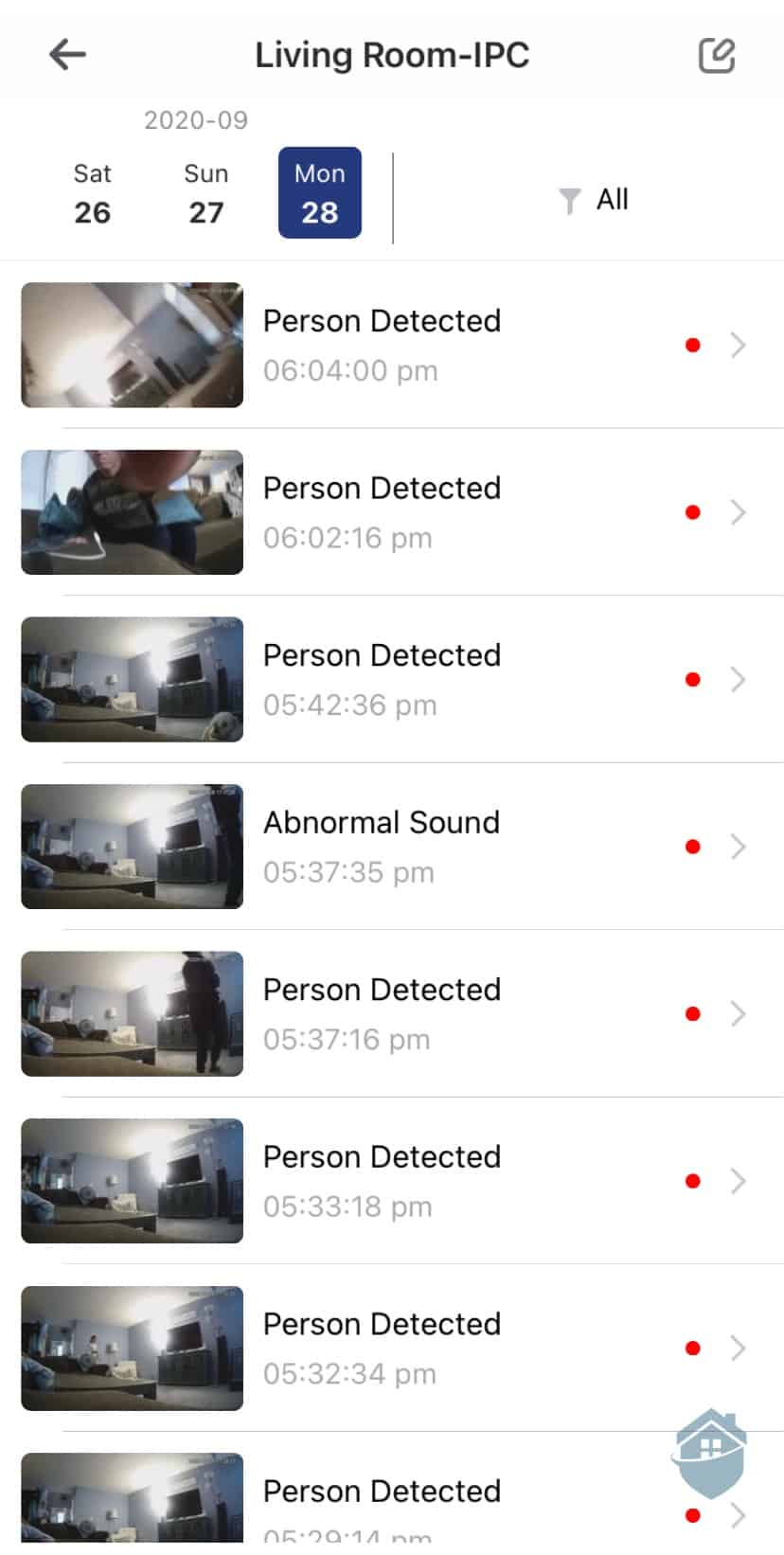
Motion Events on the Lorex app
Lorex has a lot of crowd-pleasing aspects, one of which is the affordable price of its cameras. It typically ranges between $80 to $150. We’ve even seen options under $50, like the $39.99 Smart Wi-Fi Indoor Camera we brought home. That’s right down there with the affordable Blink Mini we tested ($35) and most of Wyze’s low-cost cameras ($20-$30).
We recommend buying a Lorex package instead of going a la carte. Package deals are cheaper. They include an NVR and at least two cameras, usually starting at around $300. Here are a couple of examples:
| Lorex Fusion Collection Packages | Lorex Wireless Fusion | Lorex Fusion 4K | Lorex Fusion Indoor/Outdoor |
|---|---|---|---|
| Price | $399.99 | $589.99 | $705.99 |
| NVR | 16-channel w/ 2 TB storage | 16-channel w/ 2 TB storage | 16-channel w/ 2 TB storage |
| Indoor cameras | 4 (all 4K) | 0 | 2 (both 2K) |
| Outdoor cameras | 0 | 2 (both 4K w/ PTZ) | 4 (all 4K) |
Lorex is a money-saver for another respect as well: you don’t have to pay for a subscription service. The company does offer cloud storage for as little as $3 a month. You don’t need it, though, because you can get local storage options for absolutely nothing. Depending on the cameras you choose, you get either on-board micro-SD card storage or DVR/ NVR storage. That way you can review footage on your schedule and you have hard evidence to turn over to police should you need it. One thing you won’t get from Lorex is 24/7 professional monitoring. The company doesn’t offer this in any form. If you’re looking for low-maintenance security cameras you can monitor yourself, though, Lorex is the most affordable option out there.
Pro Tip: We recommend combining local storage with cloud backup. Some Lorex NVRs allow you to backup videos to a personal cloud drive. Others are compatible with Lorex’s optional cloud subscriptions. Take that into consideration when picking your Lorex NVR.
Unlike SimpliSafe and Ring that both offer security systems, Lorex is solely focused on cameras. But that doesn’t mean you can’t integrate it with other security equipment you own. Some Lorex NVRs – particularly those under the Fusion Collection – are compatible with Alexa and Google Assistant. That means you’ll be able to control them with your voice.
Fortunately, our NVR was compatible with Alexa, so we got to test it with our Echo Show 8. Here’s a list of commands we tested:
We’d like to note that while those voice commands worked the majority of the time, they didn’t always fire up instantaneously. There was about a five- to 10-second delay between us giving the command and Alexa responding. So while we’re thrilled that Lorex works with smart home platforms, we’re not big fans of how well those integrations work.
| Connectivity | Wi-Fi, Ethernet, or PoE |
|---|---|
| Power | Wired, battery, or PoE |
| Field of View | Up to 180° |
| Resolution | Up to 4K |
| Storage | Free local, optional cloud |
| Smart Platform Compatibility | Alexa and Google Home |

You might know Ring for its impressive line of video doorbells, but what are video doorbells? Security cameras you put on your front door. Ring has taken its video doorbell expertise to create versatile, easy-to-use cameras in the form of the Ring Indoor Cam, Stick Up Cam, Spotlight Cam, and Floodlight Cam. We personally tested all of these cameras.
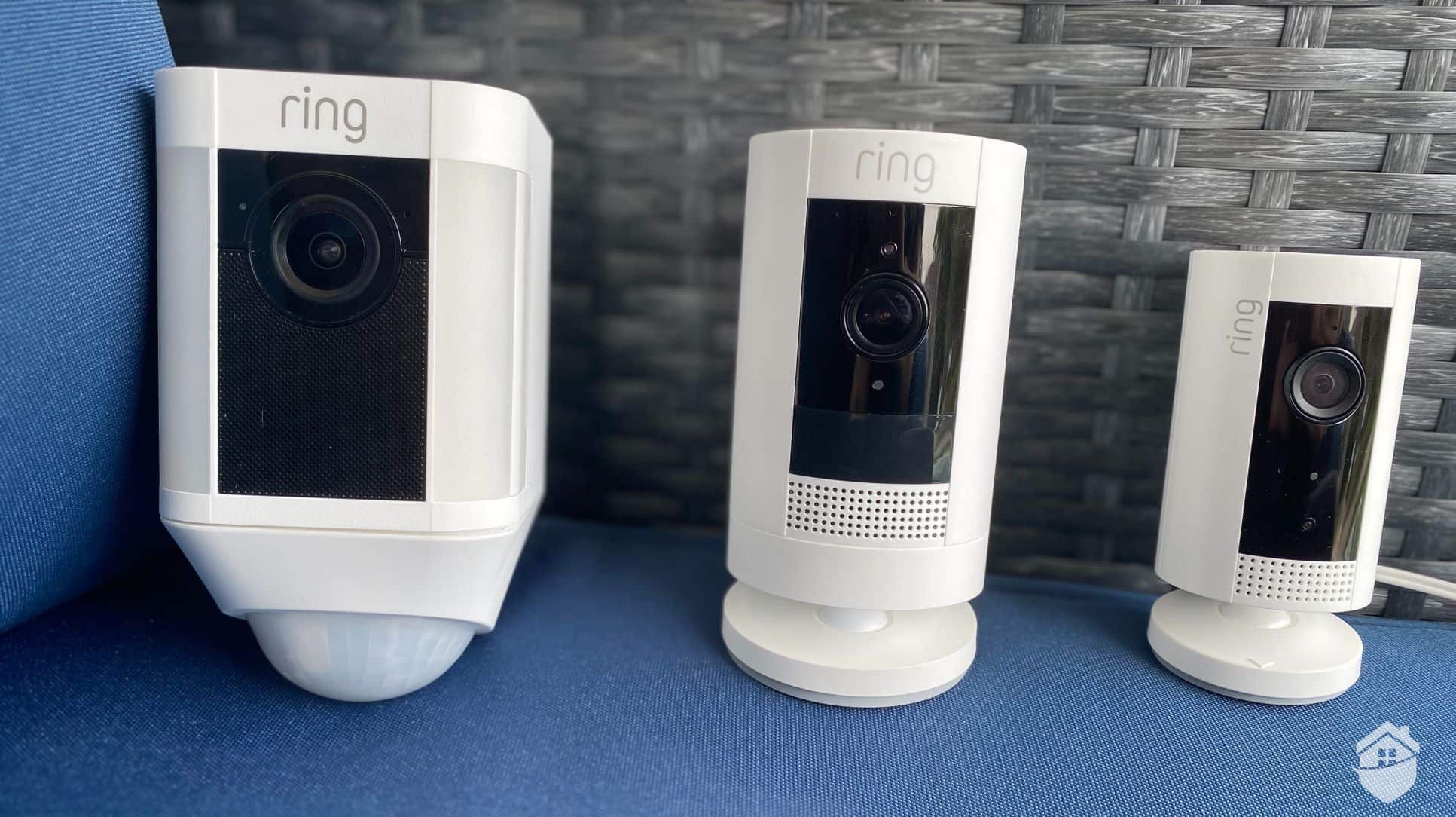
Ring’s Spotlight Cam, Stick Up Cam, and Indoor Cam
In contrast to Lorex cameras, the Ring security cameras we tested were a cinch to set up and even easier to use. All of them connected via Wi-Fi and except the Indoor Cam, all came with different power options.
| Ring Power Options | Ring Stick Up Cam | Ring Spotlight Cam | Ring Floodlight Cam |
|---|---|---|---|
| Plugged-in | Yes | Yes | Yes |
| Battery | Yes | Yes | No |
| Solar | Yes | Yes | No |
| Hardwired | No | No | Yes |
Pro Tip: You can make battery-powered Stick Up Cams and Spotlight Cams solar-powered by buying a compatible solar panel from Ring. That’s one reason that Ring made our roundup of the best wireless cameras.
Ring doesn’t offer 2K and 4K cameras like Lorex does, but it doesn’t really need to. The 1080p HD resolution coupled with HDR processing to remove glare was enough, in our opinion. We didn’t have much problem capturing small details like license plate numbers with our Ring Spotlight Cam.
The real highlight, though, is the audio. Each of those four Ring cameras has a built-in siren you can trigger manually via the app. The ones on the Stick Up Cam and Indoor Cam weren’t very loud, but the siren on our Spotlight Cam was loud enough to be heard from down the street.
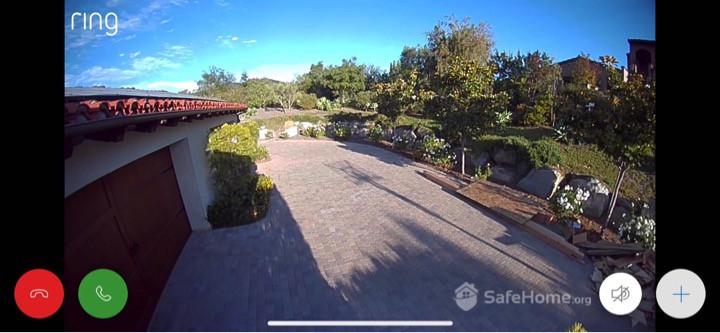
Ring Spotlight Cam Video Quality
Did You Know? Ring’s cameras come with enhanced noise cancellation, which worked really well during our tests. Even as a garbage truck passed our house, we were able to chat with the mailman outside our door with ease.
Compared to SimpliSafe’s Live Guard Protection feature, though, Ring isn’t as proactive in deterring crime. The Spotlight Cam and Floodlight Cam have motion-activated lights, but none of Ring’s cameras trigger the available siren. The only way to do that is to pull up the Ring app on your mobile device and activate it manually. That’s maybe not the best setup in a crisis.
When it comes to cost, Ring’s cameras are squarely in the middle of the industry, not cheap but not overly pricey either. Take a look at our full guide to Ring’s pricing, and see the roundup below:
| Ring Security Cameras | Pricing |
|---|---|
| Ring Indoor Cam | $59.99 |
| Ring Stick Up Cam | $99.99 to $209.99 |
| Ring Spotlight Cam | $169.99 to $249.99 |
| Ring Floodlight Cam | $199.99 to $269.99 |
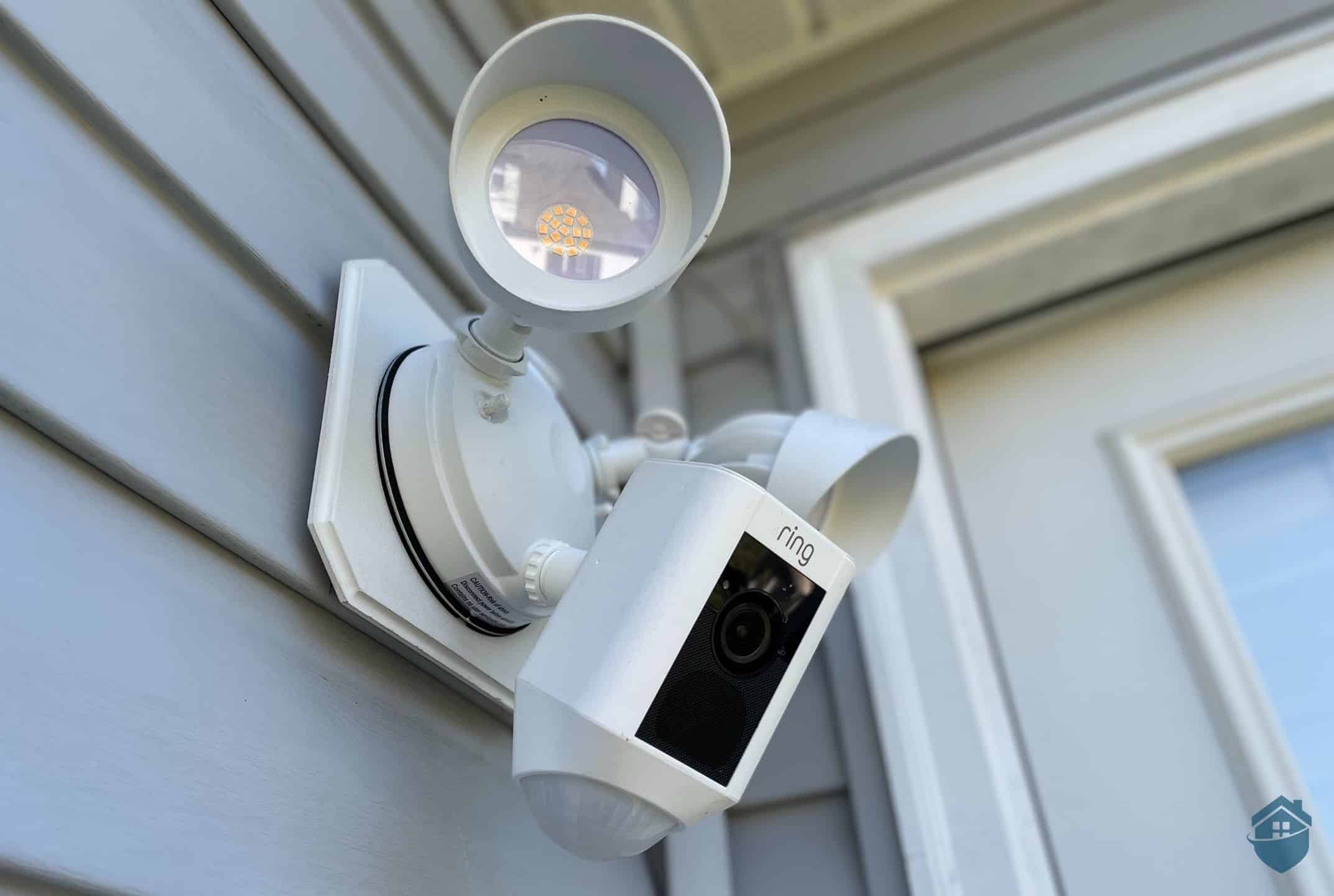
Ring Floodlight
Note that there’s a range of prices due to the different versions for each model (battery, solar, wired, etc.). Some beat comparable products from other companies, some are priced a bit higher. Overall, though, Ring’s camera pricing is right in the middle of the pack.
Even Ring’s long-term usage cost is low, thanks to its affordable cloud plans. Much like SimpliSafe, Ring cameras can only use cloud storage. Ring doesn’t offer free cloud storage, but you can get a lot with just $10 per month. For context, let’s compare Ring’s cloud plan with that of SimpliSafe.
| Features and Price | Ring Protect Plus Plan | SimpliSafe Camera Recording Plan |
|---|---|---|
| Price per month | $10 | $9.99 |
| Max no. of cameras | Unlimited | 5 |
| Video history | 180 days | 30 days |
You should know, though, that Ring’s basic professional monitoring plan doesn’t include video verification the way SimpliSafe’s Live Guard Protection does. Monitors don’t have eyes on your property under this plan. That means the system is prone to more false alerts. At the same time, it can take longer to get emergency personnel to your home since Ring calls you to verify there’s a true emergency.
If you want video monitoring with Ring, you have to sign up for an additional subscription to Virtual Security Guard. Be prepared for sticker shock, though. That service costs $99 a month, some three times what SimpliSafe charges.
And you can’t just buy a camera and sign up. Here’s what you need to activate the plan:
That’s a lot of moving parts and a lot of money. Suffice to say that if you’re in the market for live professional camera monitoring, SimpliSafe is definitely the better option. If you don’t mind monitoring your own cameras, though, or you’re interested in professional monitoring that doesn’t rely on video feeds, Ring makes for an excellent option.
| Connectivity | Wi-fi, ethernet |
|---|---|
| Power | Wired, battery, PoE |
| Field of View | Up to 140° |
| Resolution | Up to 1080p |
| Storage | Cloud |
| Smart Platform Compatibility | Alexa and Google Home |
Our home security camera recommendations come from thousands of hours of research and rigorous hands-on testing. These are products we have used ourselves, following our editorial guidelines to maintain objectivity, integrity, and accuracy.
For this specific guide, here’s what our security camera testing looked like:

Installing the Ring Floodlight Cam
This whole process took us nearly six months, and after that, we compared notes and ranked our top picks. And as you can see, SimpliSafe, Lorex, and Ring topped the rankings.
Delving deeper into our testing process, we didn’t just blindly compare security cameras. We picked three main factors we firmly believe are most important to home security camera shoppers.
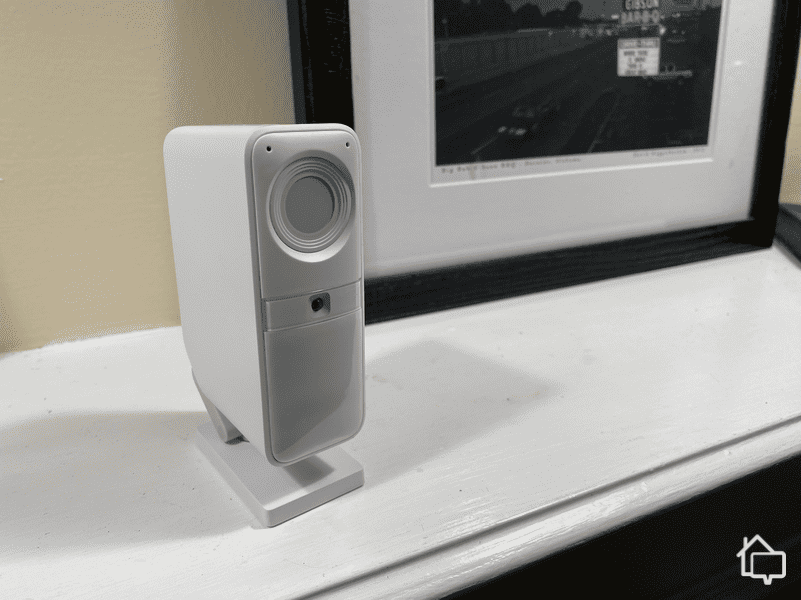
SimpiSafe’s Smart Alarm Wireless Indoor Camera
The first factor is the ease of installation, influenced greatly by whether a camera is wired or wireless.
Wired security cameras need to be plugged into a wall outlet for power and/or to a DVR for recording. They are reliable since they don’t face issues such as signal and battery power loss, but they are usually more challenging to install. On the other hand, wireless security cameras are Wi-Fi ready. Some of them are also completely wire-free since they use batteries for power.
We don’t have a preference between the two. In fact, we recommend installing a combination, and you’ll notice that all three of our entries on this list offer both types. Wireless cameras, of course, are generally easy to install and easy to maintain. Because you don’t have to worry over connecting them to your central hub, you have more flexibility in terms of where you install them. This can help with coverage. You need some wired cameras as well, particularly in outdoor areas around your house. Your Wi-Fi will be weakest in these spots, and you want to be sure you always have visual coverage on your perimeter.
>> Further Reading: Where to Place Your Security Cameras
The second factor is cost – both the upfront cost for the hardware and the on-going cost for cloud storage.
Security camera pricing varies widely depending on hardware specs and features, but we find that the typical price range is $80 to $120 for indoor cameras and $150 to $200 for outdoor cameras. The most affordable security cameras you’ll find in the market are within those price ranges. You might be able to find even cheaper options, but often at the expense of features and technology.
As for the monthly cost, expect to pay $5 to $12 per month for cloud storage. This depends on how many cameras you own and the features that come with the subscription. However, there are security cameras that work without subscriptions. Lorex and Swann are excellent examples.
Security cameras are an important piece of the home security puzzle, but they’re just that – a piece. You still need other security products if you want well-rounded home protection. Fortunately, current smart home technology has enabled security cameras to integrate with smart security systems.
There are two types of integrations we want to see from security cameras: Compatibility with home security systems and with smart platforms like Alexa and Google Assistant. The former enables seamless meshing with security-focused products like motion and entry sensors. The latter enables cameras to interact with automation-focused devices, allowing for improved user experience.
Besides those factors, we want to make sure our recommendations have most, if not all, of the necessary security camera features.
Most security cameras can detect movement, but you want them to be able to alert you quickly, too. That way, you can open up the live view in real-time and not after the subject has moved out of frame.
A functional, well-designed app is also important as it will allow you to monitor your security cameras in real-time. An intuitive smartphone app will put your home security at your fingertips whether you’re lounging on your couch or traveling halfway across the globe.

Lorex App Dashboard
Clear video is important. 4K is the gold standard and 1080p HD is the minimum we recommend. We prefer security cameras with flexible video resolution because they can adjust to the network speed when streaming or recording to keep videos flowing steadily.
A camera’s ability to see at night is just as important as its video resolution. Most cameras use Infrared night vision that turns videos black-and-white, but we’ve been seeing a lot of outdoor cameras with color night vision thanks to their built-in lights.
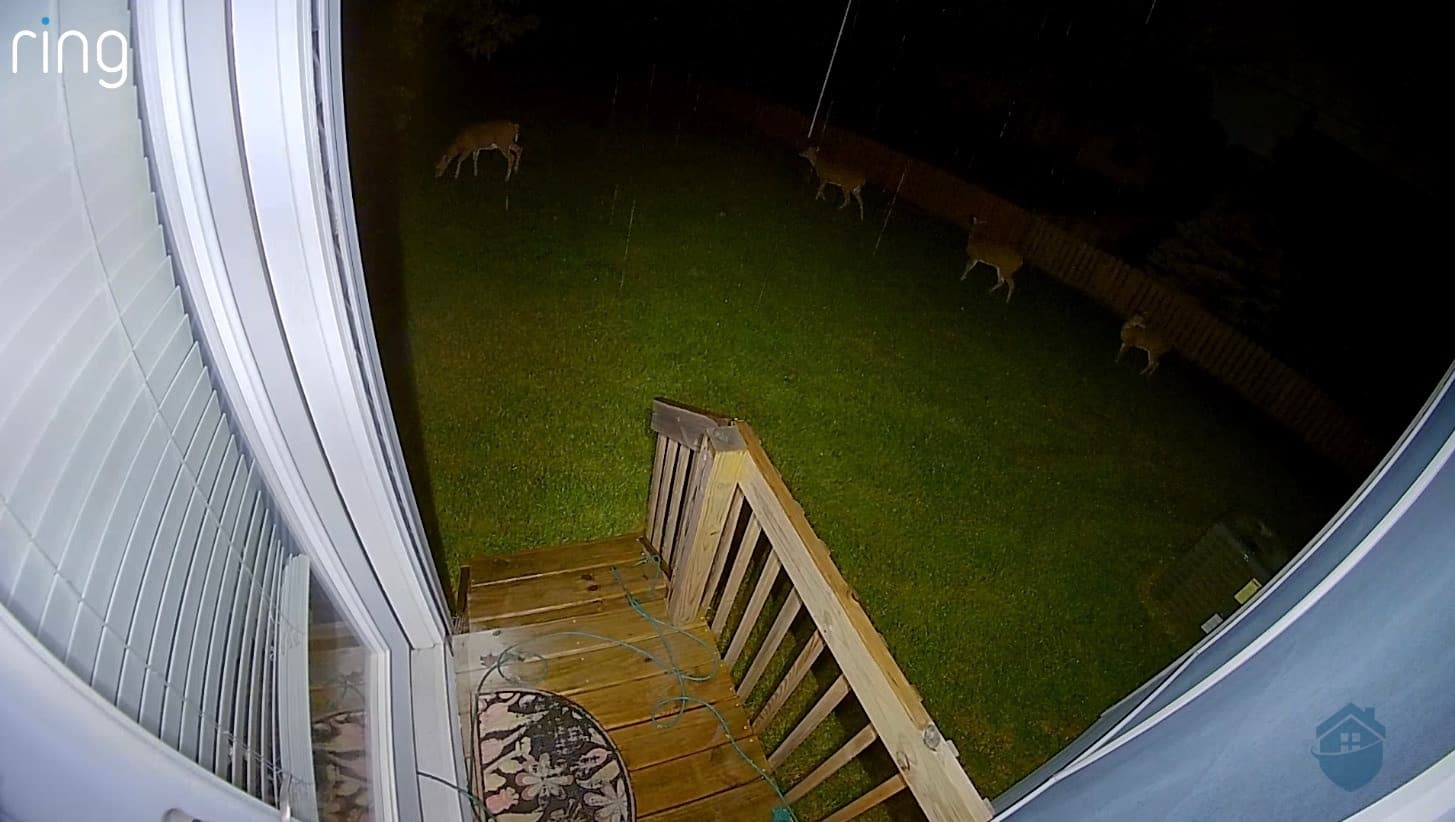
Ring Floodlight Cam Night Vision Video Quality
Few things are as scary to burglars as hearing the homeowner’s voice say the police are on the way. Two-way audio is a vital burglar-deterring feature and every indoor and outdoor camera must have it.
If a camera doesn’t deter a criminal, the next best thing it can do is gather evidence. Most cameras today use cloud video storage, but we prefer those that can store videos locally but still offer cloud backup.
Facial recognition isn’t absolutely necessary, but it helps the camera provide more insight (i.e. tell you when the movement it detected is of someone the camera recognizes). It also helps cameras avoid false alarms by ignoring non-human movements.
While SimpliSafe, Lorex, and Ring best met our criteria, they weren’t the only good options we tested. Here are 10 other security camera brands to consider if you want to expand your search horizon.
| System |
SimpliSafe

|
Lorex

|
Ring

|
|---|---|---|---|
| Ranking |
1st

|
2nd

|
3rd

|
| SecureScore™ | 9.3 | 9.2 | 9.2 |
| Best Accolade | Best Security Cameras Overall | Best Without Subscriptions | Best DIY Security Cameras |
| Equipment Cost | Starting at $99 | Starting at $40 | Starting at $59 |
| Monthly Cost | Starting at $10 | N/A | Starting at $3.00 |
| Resolution | 1080p to 1536p | 1080p to 4K | 1080p with HDR |
| Night Vision | Yes | Yes | Yes |
| Installation | Wired or wireless | Wired or wireless with NVR | Wired or wireless |
| Security System Compatibility | SimpliSafe security system | N/A | Ring Alarm and Ring Alarm Pro |
| Smart Home Compatibility | Alexa and Google Assistant | Alexa and Google Assistant | Alexa and Google Assistant |
| Video Storage | Cloud | Local and cloud | Cloud |